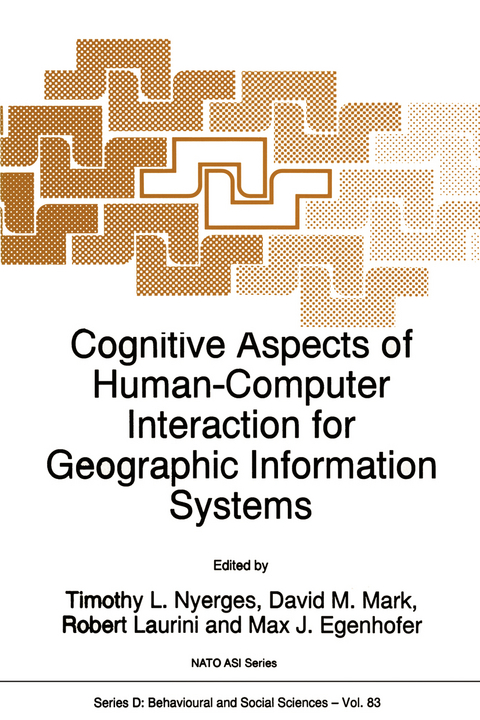
Cognitive Aspects of Human-Computer Interaction for Geographic Information Systems
Springer (Verlag)
978-0-7923-3595-5 (ISBN)
Audience: Geographic information users, systems analysts and system designers, researchers in human-computer interaction will find this book an information resource for understanding cognitive aspects of geographic information technology use, and the methods appropriate for examining this use.
Section 1: Introduction.- 1.1 Cognitive Aspects of Human-Computer Interaction for Geographic Information Systems: An Introduction.- 1.2 An Overview of HCI for GIS.- Section 2: Spatial Cognition and HCI for GIS.- 2.1 Spatial Concepts and Cognitive Models for Geographic Information Use.- 2.2 Primitives of Spatial Knowledge.- 2.3 HCI Aspects of a Framework for the Qualitative Representation of Space.- 2.4 Cognitive Issues in the Evolution of GIS User Knowledge.- Section 3: User Behavior.- 3.1 Process Tracing Methods in the Decision Sciences.- 3.2 Cognitive Modelling: Experiences in Human-Computer Interaction.- 3.3 7 ± 2 Questions and Answers about Metaphors for GIS User Interfaces.- 3.4 Feet on the Ground: Studying User-GIS Interaction in the Workplace.- Section 4: User Interfaces.- 4.1 Towards Visual Interfaces for Multi-Source Updating of Geographic Information.- 4.2 Definition of a Visual Language for GIS.- 4.3 Human-Computer Interaction Aspects of Visual-Interactive Locational Analysis.- 4.4 Some Cognitive and Technical Aspects of Hypermaps.- 4.5 Human-Computer Interaction Considerations in Terrain Modelling and Visualization.- 4.6 GIS & Multimedia Applications to Support Environmental Impact Assessment and Local Planning.- 4.7 The Natural Representation of Mapping and Surveying Data: Applying the Virtual Worlds Paradigm.- Section 5: Cross-Cultural Influences.- 5.1 Cultural Differences and Cultural Aspects in GIS.- 5.2 Protocol Analysis for Cross-Cultural GIS Design: The Importance of Encoding Resolution.- Section 6: Collaborative GIS — Computer Supported Cooperative Work.- 6.1 Understanding Collaborative Use of GIS Through Social Cognition.- 6.2 Geographic Interaction in the City Planning Context: Beyond the Multimedia Prototype.- 6.3 Cognitive Task PerformanceUsing a Spatial Decision Support System for Groups.- Section 7: Task Analysis and Design Methodologies.- 7.1 Tasks and Task Descriptions for GIS.- 7.2 A Conceptual Framework for Improving Human-Computer Interaction in Locational Decision-Making.- 7.3 A Task Analysis Approach to the Visualization of Geographic Data.- 7.4 Geographic Information Systems, Work Analysis, and System Design.- 7.5 Cognitive Ergonomics Analysis Methodology.- Section 8: Research Directions : Reports from the Discussion Groups.- Section 8: Research Directions : Reports from the Discussion Groups.- Appendix: NATO Advanced Research Workshop Participants.
| Reihe/Serie | Nato Science Series D ; 83 |
|---|---|
| Zusatzinfo | XI, 435 p. |
| Verlagsort | Dordrecht |
| Sprache | englisch |
| Maße | 155 x 235 mm |
| Themenwelt | Naturwissenschaften ► Geowissenschaften ► Geografie / Kartografie |
| ISBN-10 | 0-7923-3595-3 / 0792335953 |
| ISBN-13 | 978-0-7923-3595-5 / 9780792335955 |
| Zustand | Neuware |
| Informationen gemäß Produktsicherheitsverordnung (GPSR) | |
| Haben Sie eine Frage zum Produkt? |
aus dem Bereich


